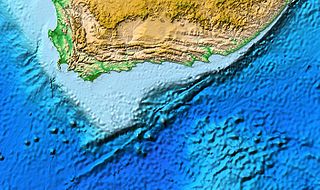Related Research Articles

The Agulhas Current is the western boundary current of the southwest Indian Ocean. It flows south along the east coast of Africa from 27°S to 40°S. It is narrow, swift and strong. It is suggested that it is the largest western boundary current in the world ocean, with an estimated net transport of 70 sverdrups, as western boundary currents at comparable latitudes transport less — Brazil Current, Gulf Stream, Kuroshio.
The East Madagascar Current is an oceanic flow feature near Madagascar. It flows southward from 20°S on the east side of Madagascar to the southern limit at Cape Saint Marie and subsequently feeds the Agulhas Current. Its flow is complicated by large cyclonic and anticyclonic eddies.

The Agulhas Bank is a broad, shallow part of the southern African continental shelf which extends up to 250 km (160 mi) south of Cape Agulhas before falling steeply to the abyssal plain.

The Mozambique Current is an ocean current in the Indian Ocean, usually defined as warm surface waters flowing south along the African east coast in the Mozambique Channel, between Mozambique and the island of Madagascar.
The Madagascar current is an oceanic current in the west Indian Ocean.

Prem Chand Pandey is an Indian space scientist, planetary scientist, and academic in the fields of satellite oceanography, remote sensing, atmospheric science, the Antarctic and climate change, and also he is the founding director of the National Centre for Polar and Ocean Research (NCPOR).

Nils Daniel Bang was a South African oceanographic scientist who was a pioneer in the study of the fine structure of coastal upwelling systems. In March 1969, Bang initiated, planned and executed South Africa's first truly multi-ship oceanographical research operation, the Agulhas Current Project, along the current's length. Although the research was conducted on a limited budget and with rudimentary equipment, Bang's studies using thousands of closely spaced bathythermograph readings were later corroborated by satellite imagery and airborne radiation thermometry.
Retroflection is the movement of an ocean current that doubles back on itself.
The Good Hope Jet is the northward-running shelf edge frontal jet of the Southern Benguela Current off the Cape Peninsula of South Africa's west coast. The jet, an intrusion of water from the Agulhas Current, was first described by South African oceanographers, Nils Bang and W.R.H. (Bill) Andrews in 1974. This warm water jet forms a sharp front as it comes into contact with the colder upwelled water over the shelf and plays a key role in carrying fish eggs and larvae from their food-poor Agulhas Bank spawning grounds to inshore nurseries.
Dr. Syed Wajih Ahmad Naqvi is an Indian marine scientist and the former director of the National Institute of Oceanography. His work has concentrated in oceanic water chemistry, biogeochemistry, and chemical interrelations with living organisms. He has also performed research on freshwater ecosystems. He was the chief Indian scientist of LOHAFEX, an ocean iron fertilization experiment jointly planned by the Council of Scientific Industrial Research (CSIR), India, and Helmholtz Foundation, Germany.

Jacob Abraham Jeremy de Villiers was a judge of the Appellate Division from 1920 to 1932 and Chief Justice of South Africa from 1929 to 1932.

The Agulhas Return Current (ARC) is an ocean current in the South Indian Ocean. The ARC contributes to the water exchange between oceans by forming a link between the South Atlantic Current and the South Indian Ocean Current. It can reach velocities of up to 4 knots and is therefore popular among participants in trans-oceanic sailing races.

The Agulhas Basin is an oceanic basin located south of South Africa where the South Atlantic Ocean and south-western Indian Ocean meet. Part of the African Plate, it is bounded by the Agulhas Ridge to the north and the Southwest Indian Ridge to the south; by the Meteor Rise to the west and the Agulhas Plateau to the east. Numerous bathymetric anomalies hint at the basin's dynamic tectonic history.
Chris Garbers is a South African scientist and former President of the Council for Scientific and Industrial Research. He was a member of the UNESCO/IUPAC International Chemistry Council for four years and served on President Nelson Mandela's National Commission on Higher Education.
Günter Dietrich was a German oceanographer. He was the first to describe the Agulhas Current in detail, he provided essential contributions to the understanding of bottom water exchange in the North Atlantic and he shaped marine research in Germany after World War II.
Gerold Siedler is a German physical oceanographer. He is professor emeritus at the Christian-Albrechts University of Kiel and at the GEOMAR Helmholtz Centre for Ocean Research Kiel.
The North Madagascar Current is an ocean current near Madagascar. The Madagascar current is split into two currents: the North Madagascar Current and the East Madagascar Current (EMC). The North Madagascar Current (NMC) flows into the South Equatorial Current just north of Madagascar and is directed into the Mozambique Channel, this connects to the gyre's equatorial currents into the Agulhas Current off the coast of Southeastern Africa.

The marine ecoregions of the South African exclusive economic zone are a set of geographically delineated regions of similar ecological characteristics on a fairly broad scale, covering the exclusive economic zone along the South African coast.

The Marine biodiversity of South Africa is the variety of living organisms that live in the seas off the coast of South Africa. It includes genetic, species and ecosystems biodiversity in a range of habitats spread over a range of ecologically varied regions, influenced by the geomorphology of the seabed and circulation of major and local water masses, which distribute both living organisms and nutrients in complex and time-variable patterns.
The Agulhas Leakage is an inflow of anomalously warm and saline water from the Indian Ocean into the South Atlantic due to the limited latitudinal extent of the African continent compared to the southern extension of the subtropical super gyre in the Indian Ocean. The process occurs during the retroflection of the Agulhas Current via shedding of anticyclonic Agulhas Rings, cyclonic eddies and direct inflow. The leakage contributes to the Atlantic Meridional Overturning Circulation (AMOC) by supplying its upper limb, which has direct climate implications.
References
- 1 2 3 4 Stapley, James (2011) In Memoriam Johann Reinder Erlers Lutjeharms. Distance Information Sharing Tool (DLIST) Agulhas and Somali Current Large Marine Ecosystems. http://www.dlist-asclme.org
- 1 2 3 Scientific Committee on Oceanic Research (SCOR)(2010) Memorials for Scientists Involved With SCOR. October 19, 2010
- ↑ Shillington, Frank (2011) Johann Lutjeharms: Oceanographer (1944–2011). South African Journal of Science 107 (9/10)
- ↑ Lutjeharms, J.R.E. and A. Jorge Da Silva (1988) The Delagoa Bight eddy. Deep-Sea Research Part A: Oceanographic Research Papers. Volume 35, Issue 4, April 1988, Pages 619–634